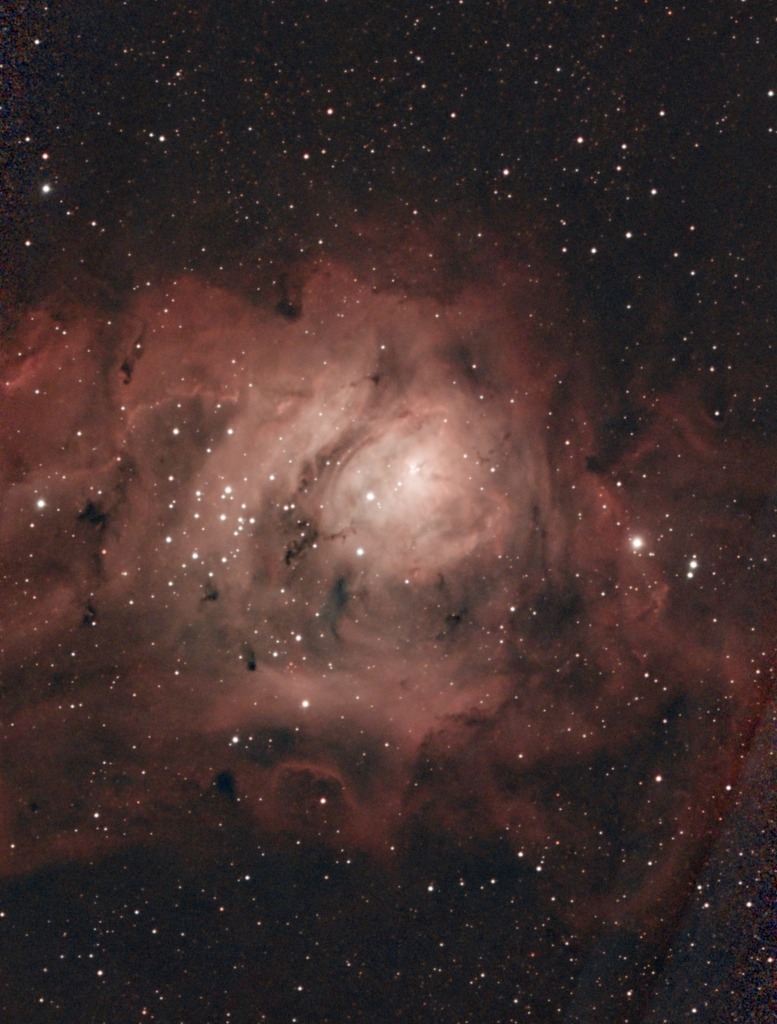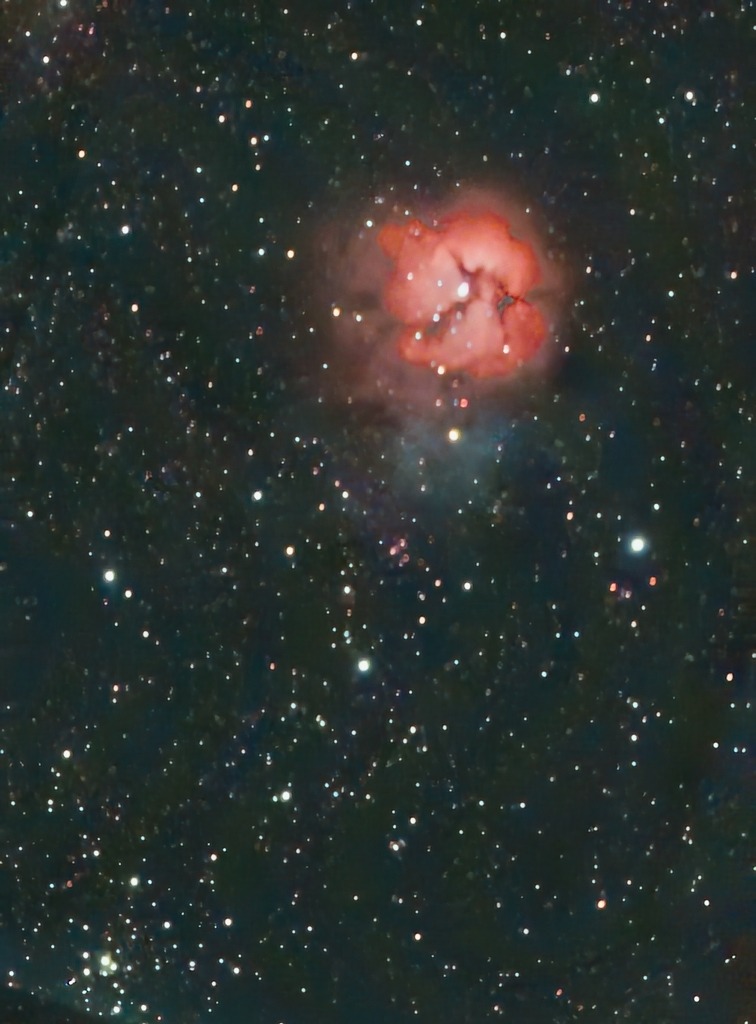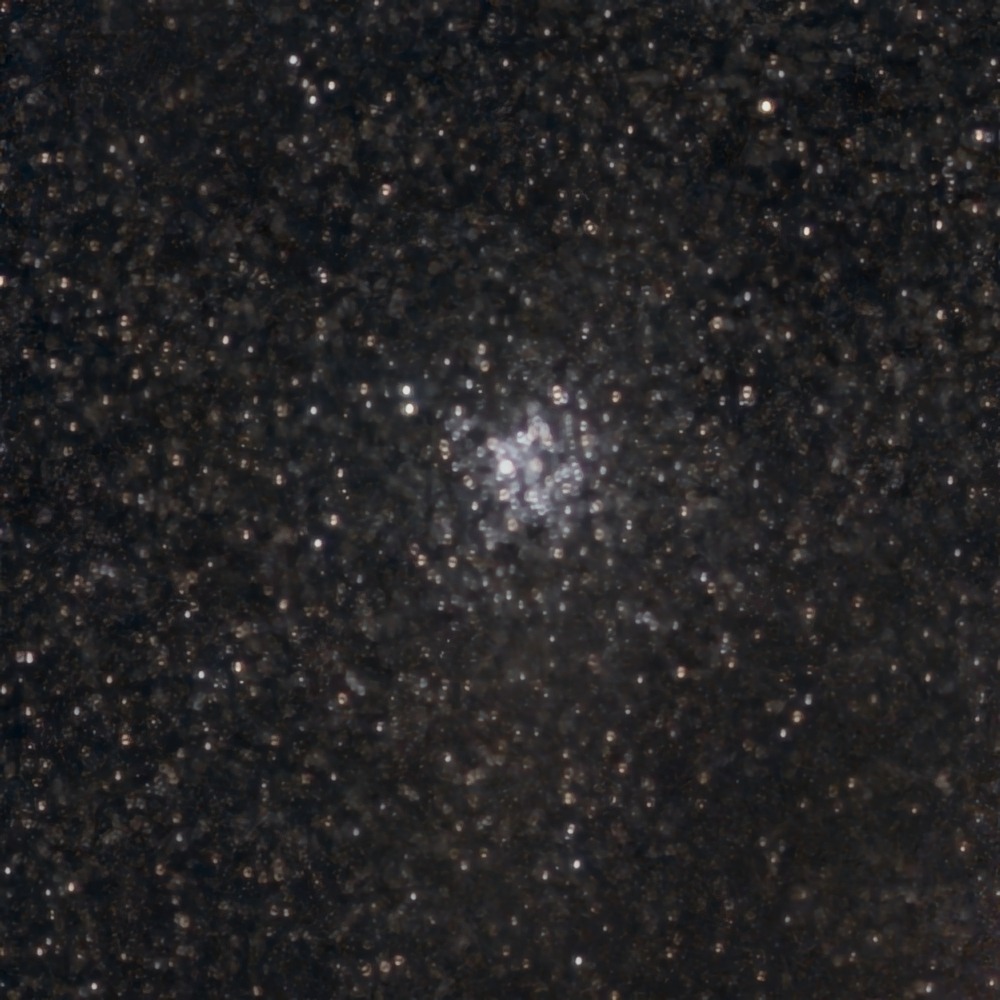After a few months filled with globular clusters, large, colorful nebulas are returning to the night sky. This month’s targets for the Hubble 35th Anniversary Challenge (see The Night Sky page for more information) are a good representation of these objects.
The Lagoon Nebula (catalogued as Messier 8, M8 or NGC 6523) is a giant emission nebula with an H II region located in the constellation Sagittarius. Discovered by Giovanni Hodierna in 1654, it is one of only two star-forming nebulae faintly visible to the naked eye from mid-northern latitudes (the other being the Orion Nebula). It is a popular photographic targets and can be combined in mosaic images with other nearby nebulae and clusters. Located approximately 4,000–6,000 light-years from Earth, the nebula spans 110 by 50 light-years.. While appearing pink in long-exposure photographs, it typically appears gray when viewed through binoculars or telescopes due to the human eye’s limited color sensitivity in low-light conditions.

The Eagle (or Star Queen) Nebula (Messier 16, M16 or NGC 6611) is a young open cluster of stars in the constellation Serpens, discovered by Jean-Philippe de Cheseaux in 1745–46. Both the “Eagle” and the “Star Queen” refer to visual impressions of the dark silhouette near the center of the nebula. This area was made famous as the “Pillars of Creation” image by the Hubble Space Telescope. The nebula contains several active star-forming gas and dust regions, including the aforementioned Pillars of Creation. You can see this area as a small v-shaped dark area in center of the nebula image below. The Eagle Nebula lies in the Sagittarius Arm of the Milky Way.

The colorful Trifid Nebula (Messier 20, M20 or NGC 6514) is another H II region in the north-west of Sagittarius in a star-forming region in the Milky Way’s Scutum–Centaurus Arm. It was discovered by Charles Messier on June 5, 1764. Its name means ‘three-lobe’. The object is an unusual combination of an open cluster of stars, an emission nebula (the relatively dense, reddish-pink portion), a reflection nebula (the mainly NNE blue portion), and a dark nebula (the apparent ‘gaps’ in the former that cause the trifurcated appearance, also designated Barnard 85). Viewed through a small telescope, the Trifid Nebula is a bright and peculiar object, and is a favorite of amateur astronomers. I was pleased to be able to pick up some of the bluish color in my photo below.

The famous Ring Nebula (Messier 57, M57 or NGC 6720) is a planetary nebula in my favorite constellation, Lyra. A “planetary” nebula has nothing to do with planets. Such a nebula is formed when a star, during the last stages of its evolution before becoming a white dwarf, expels a vast luminous envelope of ionized gas into the surrounding interstellar space. This nebula was discovered by the French astronomer Charles Messier while searching for comets in late January 1779. Messier’s report of his independent discovery of Comet Bode reached fellow French astronomer Antoine Darquier de Pellepoix two weeks later, who then independently rediscovered the nebula while following the comet.
The Ring Nebula is a small, but exquisite, object. You can see some of the concentric color circles in this image.

We coudln’t leave Spring behind without two more globular clusters. Although I have stated that these can be easier to image, these objects proved challenging due to a low position in the sky and nearly full moon when they were shot.
The interestingly named Wild Duck Cluster (Messier 11, M11 or NGC 6705) is an open cluster of stars in the constellation Scutum (the Shield). It was discovered by Gottfried Kirch in 1681. Charles Messier included it in his catalogue of diffuse objects in 1764. Its popular name derives from the brighter stars forming a triangle which could resemble a flying flock of ducks (or, from other angles, one swimming duck). The cluster is located just to the east of the Scutum Star Cloud midpoint.The Wild Duck Cluster is one of the richest and most compact of the known open clusters. It is one of the most massive open clusters known, and it has been extensively studied. Its age has been estimated to about 316 million years.

Messier 22 or M22 (also known as NGC 6656 or the Great Sagittarius Cluster) is an elliptical globular cluster of stars in the constellation Sagittarius, near the Galactic bulge region. It is one of the brightest globulars visible in the night sky. The brightest stars are 11th magnitude, with hundreds of stars bright enough to resolve with an 8″ telescope. It is just south of the sun’s position in mid-December, and northeast of Lambda Sagittarii (Kaus Borealis), the northernmost star of the “Teapot” asterism.
M22 was one of the first globulars to be discovered, in 1665 by Abraham Ihle, and it was included in Charles Messier’s catalog of comet-like objects in 1764. It was one of the first globular clusters to be carefully studied – first by Harlow Shapley in 1930. It is one of the closest globular clusters to Earth.



Leave a Reply